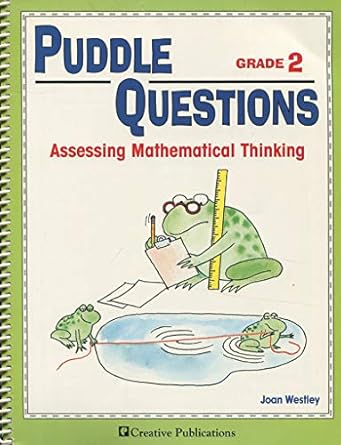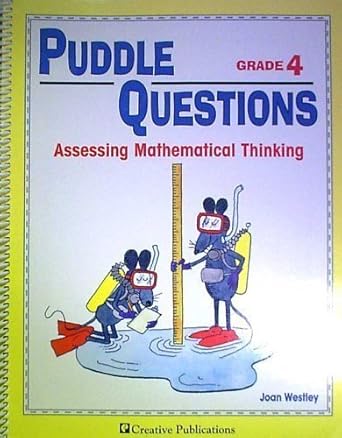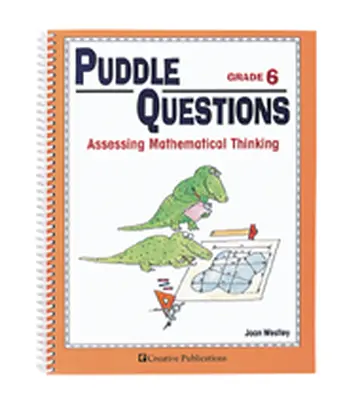I wrote a post in 2016 called Textured Cardstock and Hands-on Learning that describes my class working on a grade 8 problem, if you'd like to get a sense of how these push children to explain their mathematical thinking more fully.

For our last four weeks of the school year, I will be giving Puddle Questions to students here, each according to their age.
Happily, I finally have a complete set of these! I just found and bought the books for grades 1 and 3, after searching for a long time, and I am so very excited!


There is much more to these books than just the Puddle Questions they ask. I'm just sharing the questions so you can track down the book that you think is the best fit for your child. The wonderful thing is how much they support the children (offering open-ended questions, encouraging them to explain their mathematical thinking, helping them self-assess) AND how much they support the teacher (practical classroom management help like how big the groups of children should be during a task and what supplies are needed, plus follow-up activities, discussion questions, and extension ideas).
The books are spiral-bound, so they open easily for photocopying. Children are given the task on a 1-page sheet with the instructions (as shown below). There is always an English version of the worksheet and a Spanish version.
At the bottom there is always a place to mark their self-assessment on a scale of 1 to 4. This is an important part of the learning that's going on!
The first problem in each book is always The Puddle Problem. Joan Westley writes about giving students in a K-2 classroom the question, "How would you go about measuring a puddle," as part of a theme they were studying, and voila!
- "We had the students write their ideas on paper, using pictures and words. What came from those students that day was so interesting that it gave birth to this series -- Puddle Questions: Assessing Mathematical Thinking. When we looked at the students' responses, we discovered that their answers told us more about what they knew about measurement than any test we could have devised. Their responses were revealing in a variety of ways. They gave us information about how individual students were able to think through a complex problem, plan a solution, use tools and techniques, and communicate their thinking so others could understand it."
Here is how the Puddle Questions get more difficult as the children get older. I'm sharing the questions for grades 2, 4, 6, and 8. Enjoy!

grade 2
#1 - The Puddle Problem
How would you measure a puddle?
- Draw a picture of a puddle. Show and write all the ways you can think of to measure it.
#2 - Fruit Survey
What kinds of fruit does our class like best?
- Show the data in some way. Tell what the data show.
#3 - Picnic at the Park
Make up some word problems that can be solved using the picture.
- Make a list of your problems. Then solve all the problems.
#4 - Equations Galore!
What equations can you write for 100?
- Think of lots of different equations for 100. Make lists of equations that are alike. What do you notice?
#5 - Cup of Peanuts
Design and make a container that will hold one cup of peanuts.
- Write about your container and its size. Use pictures, numbers, and words. Why is your design a good one?
#6 - Telephone Talk
Imagine you are talking to a friend on the telephone. You would you tell your friend how to draw this picture?
- Write what you would say.
#7 - Is It Fair?
Is this game fair? If it is not fair, how can you change it to make it fair?
- Game Rules
- Take turns spinning the spinner.
- Player 1 wins a point if the number is greater than 3.
- Player 2 wins a point if the number is less than 3.
Explain your thinking.
#8 - Milk and Cookies
Plan a milk and cookies party for some friends. How many friends will you invite? How much milk and how many cookies will you need?
- Show your plan with pictures, words, and numbers.

#1 - The Puddle Problem
How would you measure a puddle?
- Record all the different ways you can think of. Make sketches to show your ways.
#2 - Favorite Subjects
What are our class's favorite school subjects? Is there a difference between boys' and girls' favorite subjects?
- You can present the data in a chart, a graph, or some other form. Then tell what the results show.
#3 - Drops in a Cup
How many drops of water do you think you would fit in a paper cup?
- Record your estimate and explain your reasoning. Why is your estimate a good one?
#4 - Equations Galore!
What equations can you write for 6?
- Think of lots of different kinds of equations for 6. Make lists of equations that are alike. What do you notice?
#5 - Four Balls
Design and build a container that will hold four table tennis balls.
- Write a report. Explain how you would make your container. Why is your design a good one?
#6 - Telephone Talk
Imagine you are talking to a friend on the telephone. How would you tell your friend how to draw this design?
- Write a list of directions.
#7 - Odds and Evens
Is this game fair? If it is not fair, how can you change it to make it fair?
-
Game Rules
- Decide who will play for odd and who for even.
- Spin the spinners and multiply the numbers.
- If the product is odd, the odd player wins a point.
- If even, the even player wins a point.
Write a report. Explain your thinking.
#8 - Diamond Park Trails
Make up some word problems that can be solved using the map. What different kinds of problems can you write?
- Write your problems. Then solve the problems.

grade 6
#1 - The Puddle Problem
How would you measure a puddle?
- Record all the different ways you can think of. Make sketches to show your ways.
#2 - Television Survey
Conduct a survey of your class about television.
- Think of a question you would ask the students in your classroom. Conduct the survey. Write a report about your results. What did you learn from the survey?
#3 - One to a Million
About how long would it take you to count to one million?
- Record your estimate and explain your reasoning. Include all of your figuring.
#4 - Equations Galore!
What equations can you write for 1/2?
- Think of lots of different equations for 1/2. Make lists of equations that are alike. What do you notice?
#5 - Doghouse Designs
Design a doghouse made with plywood.
- Write a proposal explaining how you would build the doghouse. In the proposal, show a sketch of your design labeled to show
its dimensions. Tell how much plywood you would need to build the doghouse. Why is your design a good one?
#6 - Telephone Talk
Imagine you are talking to a friend on the telephone. How could you tell your friend how to draw this design?
- Write a list of instructions.
#7 - Is it Fair?
Is this game fair? If it not fair, how can you change it to make it fair?
-
Game Rules
- Take turns spinning the spinner.
- One player always multiplies the number by 2.
- The other player always adds 4 to the number.
- The player with the greater result wins the point.
Write a report. Explain your thinking.
#8 - Lemonade Stand
Make a plan for selling lemonade.
- Write a report about your plan. Predict how many servings you will sell. How much will you spend on supplies? How much will you charge? How much will you make?
Explain your thinking. Show all your calculations.
#1 - The Puddle Problem
How would you measure a puddle?
- Record all the different ways you can think of. Make sketches to show your ways.
#2 - Sandwich Sale
Make a plan for selling sandwiches to raise money for a good cause.
- Decide what kinds of sandwiches you will offer for sale and tell exactly how you would make them. How many do you think you would sell?
Figure out your costs and decide how much you will charge. Calculate how much profit you will make.
Present your plan in a report. Explain the decisions you made and the calculations you did.
#3 - Drops in a Cup
How many drops of water do you think would fit in a paper cup?
- Record your estimate and explain how you came up with your answer. Include all of your figuring.
#4 - Garden Plotting
Plan a vegetable garden in a plot with an area of 180 square feet.
- Your garden should have a variety of kinds of vegetables. Decide what you will grow and how you will arrange the plants. Use the information on the seed packets to make your plan.
Make a scale drawing of your garden as it will look when the plants are full grown and ready to harvest.
Write a report explaining your plan. Explain your decisions and the calculations you did make your plan.
#5 - Birdhouse Designs
Design a birdhouse made with wood.
- Write a proposal explaining how you would build the birdhouse. Use boards that are 1/2" x 8" x 6'. In the proposal, show a sketch or sketches of your design labeled to show the dimensions. You may want to show different views. Tell how much wood you would need to build the birdhouse.
#6 - Telephone Talk
Imagine you are talking to a friend on the phone. How would you describe this design so that your friend could draw it exactly as shown?
- Make a set of directions that your friend can follow to reproduce the design without ever seeing it. Be as precise as you can.
#7 - Is It Fair?
Is this game fair?
- Game Rules for Two Players
- For each turn, players spin twice. Player 1 adds the numbers, and Player 2 multiplies that same two numbers.
- The player with the greater result wins a point.
Analyze the game. Tell whether the game is fair or unfair. Give proof to support your answer.
#8 - Wrapping Paper
In general, how much wrapping paper is needed to wrap a box?
- Explore boxes of different sizes and shapes. Think about the dimensions of the paper you need to wrap them. Make a rule that would work for any box. Your rule should state how to determine the length and width of the wrapping apper from the length, width, and height of a box.
Include labeled pictures or diagrams to make your rule clear. Explain how you approached the problem and came up with your rule.
The fact that they all start with the same question is perfect for introducing this work in a mixed-age classroom. They will all have the same assignment! We will have lots of sample work to look at.
More than the questions getting more challenging, the work that is expected from them gets more challenging. I just love reading the sample Exceptional, High, Medium, and Low student responses. They are actual student work, and it is so helpful for children to see what other kids wrote and how it did -- or did not -- completely explain their mathematical reasoning.
This post contains affiliate links to materials I truly use for homeschooling. Qualifying purchases provide me with revenue. Thank you for your support!





 Immersive Experience
Immersive Experience Immersive Experience
Immersive Experience







1 comment:
There is also a series of Puddle Questions for Science, which only goes through grade 6. These are even harder to track down, so if you spot one... grab it!
Post a Comment